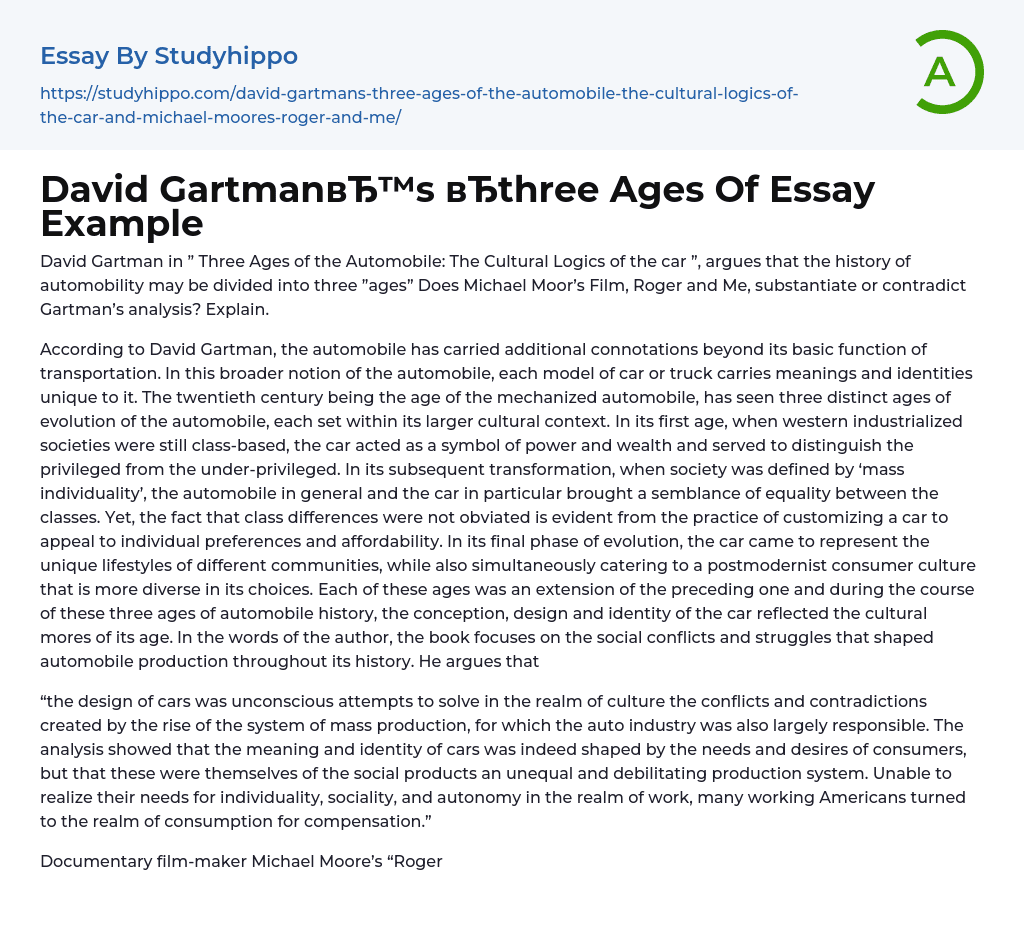According to David Gartman's book "Three Ages of the Automobile: The Cultural Logics of the Car," the history of cars can be classified into three distinct "ages." This raises the question of whether Michael Moore's documentary film "Roger and Me" aligns with or challenges Gartman's analysis. In Gartman's view, cars have significance beyond mere transportation, as each model embodies distinct meanings and identities. Throughout the twentieth century, which is commonly known as the era of mechanized automobiles, there have been three specific periods in which the automobile industry has evolved within a broader cultural context.
Throughout the evolution of western industrialized societies, cars have been a powerful symbol of power and wealth, highlighting social class disparities. However, as society advanced towards a period of 'mass individuality', cars became an equalizer among classes. Nevertheless, class distinctions persisted through customized cars b
...ased on personal preferences and budgets. In its final phase, cars began to represent distinct lifestyles within communities while also catering to a consumer culture influenced by postmodernism. Each stage in automotive history built upon previous ones, with cars reflecting cultural norms at each point in time.
According to the author, the book examines the social conflicts and struggles that influenced the history of automobile production. It argues that car designs were unconsciously attempting to resolve the conflicts and contradictions caused by mass production, for which the auto industry bears responsibility. The analysis demonstrates that while consumer needs and desires shaped the meaning and identity of cars, these needs themselves were products of an unequal and debilitating production system. Many working Americans sought compensation for unmet needs for individuality, sociality, and autonomy through consumption. Michael Moore's documentary film
"Roger and Me" shares a similar theme, although it does not directly reference David Gartman's theory of the "Three Ages of the Automobile". Both works agree on the harsh realities of the car manufacturing industry.
The title Roger and Me refers to Roger Smith, the CEO of General Motors, who is blamed for job losses in the company's Flint, Michigan manufacturing plant. Michael Moore suggests in his documentary that Smith could have prevented these job losses if he wasn't focused on corporate greed. This perspective aligns with David Gartman's belief that cars are a result of an unfair production system that disadvantages individuals. Gartman's work depicts the harsh social realities and disempowerment of the American people, which is consistent with the theme of Michael Moore's documentary Roger and Me.
According to David Gartman in his book "Three Ages of the Automobile: The Cultural Logics of the Car," the history of automobility can be divided into three "ages." In Michael Moore's film "Roger and Me," there is evidence that supports Gartman's analysis. Gartman argues that the automobile holds more significance than just being a mode of transportation; it carries additional connotations and unique identities for each model. Throughout the twentieth century, as the age of the mechanized automobile progressed, there were three distinct ages of evolution, each within its cultural context. Does "Roger and Me" by Michael Moore confirm or challenge Gartman's analysis? This question remains to be explained.
In the early days, when western industrialized societies were still divided into classes, the car symbolized power and wealth, setting apart the privileged from the underprivileged. Later on,
- Renault essays
- Truck essays
- chrysler essays
- The city essays
- Racing essays
- Age Of Enlightenment essays
- Ethos essays
- Time essays
- Acceptance essays
- Meaning Of Life essays
- Reality essays
- Natural Law essays
- Political Philosophy essays
- Utilitarianism essays
- Existence essays
- Free Will essays
- Good And Evil essays
- Confucianism essays
- Relativism essays
- Conscience essays
- Environmentalism essays
- Empiricism essays
- Epistemology essays
- Ethics essays
- Existentialism essays
- Human Nature essays
- Individualism essays
- Metaphysics essays
- Philosophy Of Life essays
- Transcendentalism essays
- Truth essays
- Destiny essays
- Determinism essays
- Fate essays
- Functionalism essays
- Philosophers essays
- Pragmatism essays
- Future essays
- Child Observation essays
- Critical Reflection essays
- Teaching Philosophy essays
- Personal Philosophy essays
- Action Speak Louder Than Words essays
- Can Money Buy Happiness essays
- Values of Life essays
- Ethical dilemma essays
- Normative Ethics essays
- Virtue Ethics essays
- Belief essays
- Deontology essays




